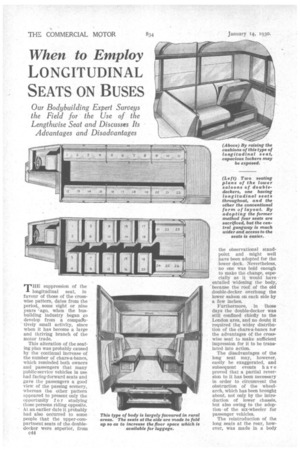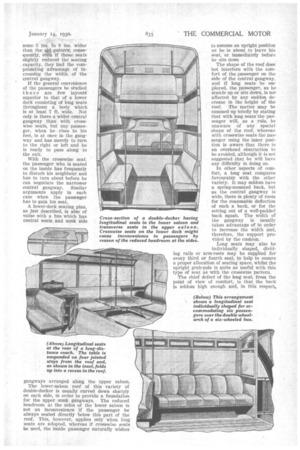When to Employ LONGITUDINAL SEATS ON BUSES
Page 66

Page 67

Page 68

If you've noticed an error in this article please click here to report it so we can fix it.
Our Bodybuilding Expert Surveys the Field for the Use of the Lengthwise Seat and Discusses Its Advantages and Disadvantages
THE suppression of the longitudinal seat, in favour of those of the crosswise pattern, dates from the period,, some eight or nine years • ago, when the busbuilding industry began to develop from a comparkttively small activity, since when it has become a large and thriving branch of the motor trade.
This alteration of the seating plan was probably caused by the continual increase of the number of chars-a-banes, which reminded both owners and passengers that many public-service vehicles in use had facing-forward seats and gave the passengers a good view of the passing scenery, whereas the other pattern appeared to present only the opportunity f o r studying those persons riding opposite. Al an earlier date it probably had also occurred to some people that the upper-compartment seats of the doubledecker were superior, from c44 the observational standpoint and might well have been adopted for the lower deck. Nevertheless, no one was bold enough to make the change, especially as it would have entailed widening the body, because the• roof of the old double-decker overhung the lower saloon on each side by a few inches.
Furthermore, in those days the double-decker was still confined chiefly to the London area, and no doubt it required the wider distribution of the chars-a-banes for the advantages of the crosswise seat to make sufficient impression for it to be translated into action.
The disadvantages of the long seat may, however, easily be exaggerated, and subsequent events have proved that a partial reversion to it has been necessary in order to circumvent the obstruction of the wheelarch, which has been brought about, not only by the introduction of lower chassis, but also owing to the adoption of the six-wheeler for passenger vehicles.
The reintroduction of the long seats at the rear, however, was made in a body
some i ins. to 6 ins, wider than the old; pattern; consequently, een if these: seats slightly reduced the seating . capacity, they had the compensating advantage of increasing the width of the central gangway.
If the general convenience of the passengers be studied t her e are few layouts superior to that of a lower deck consisting of 'Ong seats throughout a body which is at least 7 ft. wide. Not only is there a wider central gangway than with crosswise seats, but any passenger, when he rises to his feet, is at once in the gangway and has merely to turn to the right or left and he is ready to pass along to the exit.
With the crosswise seat, the passenger who is seated on the inside has frequently to, disturb his neighbour and has to turn about before he can negotiate the narrower central gangway. Similar arguments apply in each case when the passenger has to gain his seat.
A lower-deck seating plan, as just described, is also of value with a bus which has central seats and sunk side gangways arranged along the upper saloon.
The lower-saloon roof of this variety of double-decker is usually curved down sharply on each side, in order to provide a foundation for the upper sunk gangways. The reduced headroom at the sides of the lower saloon is not an inconvenience if the passenger be always seated directly below this part of the roof. This, however, applies only when long seats are adopted, whereas if crosswise seats be used, the inside passenger naturally wishes to assume an upright position as he is about to leave his seat, or immediately before he sits down
The shape of the roof does hot interfere with the comfort of the passenger on the side of the central gangway, and if long seats be employed, the passenger, as he stands up or sits down, is not, affected by any sudden decrease in the height of the roof. The matter may be summed up briefly by stating that with long seats the passenger will, as a rule, be unaware of any special shape of the roof, whereas with crosswise seats the passenger using the inner position is aware that there is an overhead obstruction to be avoided, although it is tiot suggested that he will have any difficulty in doing so.
In other aspects of comfort, a long seat compares favourably with the other variety. It may seldom have a spring-mounted back, but as the central gangway is wide, there is plenty of room for the reasonable deflection of such a back, or for the setting out of a well-padded back squab. The width of the gangway is usually taken advantage of in order to increase the width and, therefore, the support provided by the cushion.
Long seats may also be individually shaped, dividing rails or arm-rests may be supplied for every third or fourth seat, to help to ensure a proper allocation of seating space, whilst the upright grab-pole is quite as useful with this type Of seat as with the croSswise pattern.
The chief defect of the long seat, from the point of view of comfort, is that the back is seldom high enough and, in this respect,
compares unfavourably with the modern facing-forward ,seat. To increase the height of the back would entail the reduction of the height of the windows. There is, however, no reason why the side waist rails should not, in the ease of a large singledecker, be raised an inch or two, because the cantrails could also be raised without giving the vehicle an unbalanced or old-fashioned appearance. On the other hand, a compromise could be effected by introducing a clerestory roof, which would easily make up for any natural lighting lost at the sides of the body.
The long seat is a simpler structure than is the crosswise pattern and, if necessgry, can easily be designed so that, in a country bus, it may he folded up in order to provide space for luggage. Even if not folded, the wide gangway affords a certain amount of spaee for parcels, which can be placed on the floor, close to the seats, when the latter are occupied. The long seat may also be made with the seat squab forming a lid, which gives access to a comparatively large locker, the front of which is a heelboard.
The long seat may further be used on one side of the bus. ,with single crass-wise seats on the other. This variation in the seating plan might be suitable for a small bus which is not of maximum width: The longitudinal seat, although usually avoided by builders of long-distance coach bodies, can, in conjunction with a large central table, be adopted for part of the vehicle. Such an arrangement would probably appeal to private parties. This table, when not in use, may be slung into the roof, or taken down in sections and placed in a convenient locker.












































































































